Two-Dimensional Distributed Transmission-Line Models for Broadband Full-Tensor Anisotropic Acoustic Metamaterials Based on Transformation Acoustics
Abstract
:1. Introduction
2. Methods
2.1. Design Formulas
2.2. Proposed Acoustic Waveguide Unit Cell Structures
2.3. Design of an Acoustic Carpet Cloak and an Illusion Medium
3. Results and Discussion
3.1. Acoustic Carpet Cloak
3.2. Acoustic Illusion Medium
4. Conclusions
Author Contributions
Funding
Data Availability Statement
Acknowledgments
Conflicts of Interest
References
- Christopoulos, C. The Transmission-Line Modeling Method: TLM; IEEE: New York, NY, USA, 1995; pp. 51–100. [Google Scholar]
- Caloz, C.; Itoh, T. Application of the transmission line theory of left-handed (LH) materials to the realization of a microstrip LH transmission line. IEEE Antennas Propag. Soc. Int. Symp. 2002, 2, 412–415. [Google Scholar]
- Oliner, A.A. A periodic-structure negative-refractive-index medium without resonant elements. IEEE AP-S/URSI Int. Symp. Dig. 2002, 2002, 41. [Google Scholar]
- Eleftheriades, G.V.; Iyer, A.K.; Kremer, P.C. Planar negative refractive index media using periodically L–C loaded transmission lines. IEEE Trans. Microw. Theory Techn. 2002, 50, 2702–2712. [Google Scholar] [CrossRef]
- Sanada, A.; Caloz, C.; Itoh, T. Characteristics of the composite right/left-handed transmission lines. IEEE Microw. Wirel. Comp. Lett. 2004, 14, 68–70. [Google Scholar] [CrossRef]
- Sanada, A.; Caloz, C.; Itoh, T. Planar distributed structures with negative refractive index. IEEE Trans. Microw. Theory Tech. 2004, 52, 1252–1263. [Google Scholar] [CrossRef]
- Nagayama, T.; Sanada, A. Physical equivalent circuit model for 2D full-tensor anisotropic metamaterials. IEEE MTT-S Int. Microw. Symp. Dig. 2013, 1–3. [Google Scholar]
- Nagayama, T.; Sanada, A. Planar distributed full-tensor anisotropic metamaterials for transformation electromagnetics. IEEE Trans. Microw. Theory Techn. 2015, 63, 3851–3861. [Google Scholar] [CrossRef]
- Pendry, J.B.; Schurig, D.; Smith, D.R. Controlling electromagnetic fields. Science 2006, 312, 1780–1782. [Google Scholar] [CrossRef] [PubMed] [Green Version]
- Schurig, D.; Pendry, J.B.; Smith, D.R. Calculation of material properties and ray tracing in transformation media. Opt. Exp. 2006, 14, 9794–9804. [Google Scholar] [CrossRef]
- Schurig, D.; Mock, J.J.; Justice, B.J.; Cummer, S.A.; Pendry, J.B.; Starr, A.F.; Smith, D.R. Metamaterial electromagnetic cloak at microwave frequencies. Science 2006, 314, 977–980. [Google Scholar] [CrossRef] [PubMed] [Green Version]
- Alitalo, P.; Luukkonen, O.; Jylhä, L.; Venermo, J.; Tretyakov, S. Transmission-line networks cloaking objects from electromagnetic fields. IEEE Trans. Antennas Propagat. 2008, 56, 416–424. [Google Scholar] [CrossRef] [Green Version]
- Tretyakov, S.; Alitalo, P.; Luukkonen, O.; Simovski, C. Broadband electromagnetic cloaking of long cylindrical objects. Phys. Rev. Lett. 2009, 103, 103905. [Google Scholar] [CrossRef] [PubMed]
- Liu, X.; Li, C.; Yao, K.; Meng, X.; Feng, W.; Wu, B.; Li, F. Experimental verification of broadband invisibility using a cloak based on inductor-capacitor networks. Appl. Phys. Lett. 2009, 95, 191107. [Google Scholar] [CrossRef]
- Kanté, B.; Germain, D.; de Lustrac, A. Experimentaldemonstration of a nonmagnetic metamaterial cloak at microwave frequencies. Phys. Rev. B 2009, 80, 201104. [Google Scholar] [CrossRef] [Green Version]
- Alù, A. Mantle cloak: Invisibility induced by a surface. Phys. Rev. B 2009, 80, 245115. [Google Scholar] [CrossRef]
- Padooru, Y.R.; Yakovlev, A.B.; Chen, P.-Y.; Alù, A. Analytical modeling of conformal mantle cloaks for cylindrical objects using subwavelength printed and slotted arrays. Appl. Phys. Lett. 2012, 112, 034907. [Google Scholar]
- Selvanayagam, M.; Eleftheriades, G. An active electromagnetic cloak based on the equivalence principle. IEEE Antennas Microw. Wirel. Propag. Lett. 2012, 11, 10. [Google Scholar]
- Selvanayagam, M.; Eleftheriades, G. Experimental demonstration of active electromagnetic cloaking. Phys. Rev. X 2013, 3, 041011. [Google Scholar] [CrossRef] [Green Version]
- Schofield, R.S.; Soric, J.C.; Rainwater, D.; Kerkhoff, A.; Alù, A. Scattering suppression and wideband tenability of a flexible mantle cloak for finite-length conducting rods. New J. Phys. 2014, 16, 063063. [Google Scholar] [CrossRef]
- Sun, F.; Liu, Y.; He, S. Surface transformation multi-physics for controlling electromagnetic and acoustic waves simultaneously. Opt. Exp. 2020, 28, 94–106. [Google Scholar] [CrossRef]
- Zhen, Z.; Qian, C.; Jia, Y.; Fan, Z.; Hao, R.; Cai, T.; Zheng, B.; Chen, H.; Li, E. Realizing transmitted metasurface cloak by a tandem neural network. Photonics. Res. 2021, 9, B229. [Google Scholar] [CrossRef]
- Li, J.; Pendry, J.B. Hiding under the carpet: A new strategy for cloaking. Phys. Rev. Lett. 2008, 101, 203901. [Google Scholar] [CrossRef] [PubMed] [Green Version]
- Liu, R.; Ji, C.; Mock, J.J.; Chin, J.Y.; Cui, T.J.; Smith, D.R. Broadband ground-plane cloak. Science 2009, 323, 366–369. [Google Scholar] [CrossRef] [PubMed]
- Valentine, J.; Li, J.; Zentgraf, T.; Bartal, G.; Zhang, X. An optical cloak made of dielectrics. Nat. Mater. 2009, 8, 568–571. [Google Scholar] [CrossRef] [PubMed] [Green Version]
- Lee, J.H.; Blair, J.; Tamma, V.A.; Wu, Q.; Rhee, S.J.; Summers, C.J.; Park, W. Direct visualization of optical frequency invisibility cloak based on silicon nanorod array. Opt. Exp. 2009, 17, 12922–12928. [Google Scholar] [CrossRef]
- Gabrielli, L.H.; Cardenas, J.; Poitras, C.B.; Lipson, M. Silicon nanostructure cloak operating at optical frequencies. Nature Photon. 2009, 3, 461–463. [Google Scholar] [CrossRef] [Green Version]
- Ergin, T.; Stenger, N.; Brenner, P.; Pendry, J.B.; Wegener, M. Three-dimensional invisibility cloak at optical wavelengths. Science 2010, 328, 337–339. [Google Scholar] [CrossRef] [Green Version]
- Ma, H.F.; Cui, T.J. Three-dimensional broadband ground-plane cloak made of metamaterials. Nat. Commun. 2011, 1, 21. [Google Scholar] [CrossRef] [Green Version]
- Huang, Y.; Zhang, J.; Zhou, J.; Qiang, B.; Xu, Z.; Liu, L.; Tao, J.; Kossowski, N.; Wang, Q.; Luo, Y. Polarization-robust mid-infrared carpet cloak with minimized lateral shift. Photonics. Res. 2021, 9, 944. [Google Scholar] [CrossRef]
- Lai, Y.; Ng, J.; Chen, H.Y.; Han, D.Z.; Xiao, J.J.; Zhang, Z.Q.; Chan, C.T. Illusion Optics: The optical transformation of an object into another object. Phys. Rev. Lett. 2009, 102, 253902. [Google Scholar] [CrossRef] [Green Version]
- Nagayama, T.; Sanada, A. Broadband transmission-line illusions based on transformation electromagnetics. EPJ Appl. Metamat. 2019, 6, 23. [Google Scholar] [CrossRef] [Green Version]
- Nagayama, T.; Uchida, S.; Fukushima, S.; Watanabe, T. Equivalent Circuit models for two-dimensional full-tensor anisotropic acoustic metamaterials. In Proceedings of the 2019 Photonics and Electromagnetics Research Symposium-Fall (PIERS-Fall), Xiamen, China, 17–20 December 2019; pp. 989–995. [Google Scholar]
- Toshima, A.; Nagayama, T.; Fukushima, S.; Watanabe, T. Acoustic illusion medium mimicking scattered waves of a groove on a flat surface based on transformation acoustics. In Proceedings of the 2021 Photonics and Electromagnetics Research Symposium (PIERS), Hangzhou, China, 21–25 November 2021; pp. 2587–2592. [Google Scholar]
- Cummer, S.A.; Schurig, D. One path to acoustic cloaking. New J. Phys. 2007, 9, 45. [Google Scholar] [CrossRef]
- Chen, H.; Chan, C.T. Acoustic cloaking in three dimensions using acoustic metamaterials. Appl. Phys. Lett. 2007, 91, 183518. [Google Scholar] [CrossRef]
- Norris, A.N. Acoustic cloaking theory. Proc. R. Soc. A Math. Phys. Eng. Sci. 2008, 464, 2411–2434. [Google Scholar] [CrossRef]
- Torrent, D.; Sánchez-Dehesa, J. Acoustic cloaking in two dimensions: A feasible approach. New J. Phys. 2008, 10, 063015. [Google Scholar] [CrossRef]
- Zhang, S.; Xia, C.; Fang, N. Broadband acoustic cloak for ultrasound waves. Phys. Rev. Lett. 2011, 106, 024301. [Google Scholar] [CrossRef]
- García-Chocano, V.M.; Sanchis, L.; Díaz-Rubio, A.; Martínez-Pastor, J.; Cervera, F.; Llopis-Pontiveros, R.; Sánchez-Dehesa, J. Acoustic cloak for airborne sound by inverse design. Appl. Phys. Lett. 2011, 99, 074102. [Google Scholar] [CrossRef]
- Guild, M.D.; Haberman, M.R.; Alù, A. Plasmonic-type acoustic cloak made of a bilaminate shell. Phys. Rev. B 2012, 86, 104302. [Google Scholar] [CrossRef]
- Jo, C.; Jeong, J.; Kwon, B.-J.; Park, K.-C.; Oh, I.-K. Omnidirectional two-dimensional acoustic cloak by axisymmetric cylindrical lattices. Wave Motion 2015, 54, 157–169. [Google Scholar] [CrossRef]
- Farhat, M.; Guenneau, S.; Alù, A.; Wu, Y. Scattering cancellation technique for acoustic spinning objects. Phys. Rev. B 2020, 101, 174111. [Google Scholar] [CrossRef]
- Lin, C.; Liu, D.; Eggler, D.; Kessissoglou, N. Active acoustic cloaking and illusions of sound-hard bodies using the boundary element method. J. Acoust. Soc. Am. 2021, 149, 1803–1812. [Google Scholar] [CrossRef] [PubMed]
- Ahmed, W.W.; Farhat, M.; Zhang, X.; Wu, Y. Deterministic and probabilistic deep learning models for inverse design of broadband acoustic cloak. Phys. Rev. Res. 2021, 3, 013142. [Google Scholar] [CrossRef]
- Fujii, G.; Takahashi, M.; Akimoto, Y. Acoustic cloak designed by topology optimization for acoustic–elastic coupled systems. Appl. Phys. Lett. 2021, 118, 101102. [Google Scholar] [CrossRef]
- Matsushima, K.; Noguchi, Y.; Yamada, T. Omnidirectional acoustic cloaking against airborne sound realized by a locally resonant sonic material. Sci. Rep. 2022, 12, 16383. [Google Scholar] [CrossRef]
- Popa, B.-I.; Zigoneanu, L.; Cummer, S.A. Experimental acoustic ground cloak in air. Phys. Rev. Lett. 2011, 106, 253901. [Google Scholar] [CrossRef]
- Popa, B.-I.; Cummer, S.A. Homogeneous and compact acoustic ground cloaks. Phys. Rev. B 2011, 83, 224304. [Google Scholar] [CrossRef] [Green Version]
- Zigoneanu, L.; Popa, B.-I.; Cummer, S.A. Three-dimensional broadband omnidirectional acoustic ground cloak. Nat. Mater. 2014, 13, 352–355. [Google Scholar] [CrossRef] [Green Version]
- Bi, Y.; Lu, W.; Ji, P.; Yang, J. Design and demonstration of an underwater acoustic carper cloak. Sci. Rep. 2017, 7, 705. [Google Scholar] [CrossRef] [Green Version]
- Chen, J.; Liu, J. Broadband underwater acoustic carpet cloak based on pentamode materials under normal incidence. AIP Adv. 2018, 8, 085024. [Google Scholar] [CrossRef]
- Guo, J.; Zhou, J. An ultrathin acoustic carpet cloak based on resonators with extended necks. J. Phys. D Appl. Phys. 2020, 53, 505501. [Google Scholar] [CrossRef]
- Xue, Y.; Zhang, X. Self-adaptive acoustic cloak enabled by soft mechanical metamaterials. Extrem. Mech. Lett. 2021, 46, 101347. [Google Scholar] [CrossRef]
- Eslamzadeh, S.; Ghaffari-Miab, M.; Abbasi-Arand, B. Design of a broadband metamaterial-based acoustic lens using elaborated carpet cloak strategy. Appl. Phys. A 2021, 127, 897. [Google Scholar] [CrossRef]
- Zhou, P.; Jia, H.; Bi, Y.; Liao, B.; Yang, Y.; Yan, Y.; Yan, K.; Zhang, J.; Yang, J. Underwater Carpet Cloak for Broadband and Wide-Angle Acoustic Camouflage Based on Three-Component Metafluid. Phys. Rev. Appl. 2022, 18, 014050. [Google Scholar] [CrossRef]
- Kan, W.; Liang, B.; Zhu, X.; Li, R.; Zou, X.; Wu, H.; Yang, J.; Cheng, J. Acoustic illusion near boundaries of arbitrary curved geometry. Sci. Rep. 2013, 3, 1427. [Google Scholar] [CrossRef] [PubMed] [Green Version]
- Kan, W.; Liang, B.; Ji, R.; Jiang, X.; Zou, Z.; Yin, L.-I.; Cheng, J. Three-dimensional broadband acoustic illusion cloak for sound-hard boundaries of curved geometry. Sci. Rep. 2016, 6, 36936. [Google Scholar] [CrossRef]
- Eggler, D.; Kessissoglou, N. Active structural acoustic illusions. Sci. Rep. 2020, 10, 9772. [Google Scholar] [CrossRef]
- Hu, C.; Yin, Y.; Chen, H. Three-Dimensional Omnidirectional Acoustic Illusion. Phys. Rev. Appl. 2022, 18, 024049. [Google Scholar] [CrossRef]




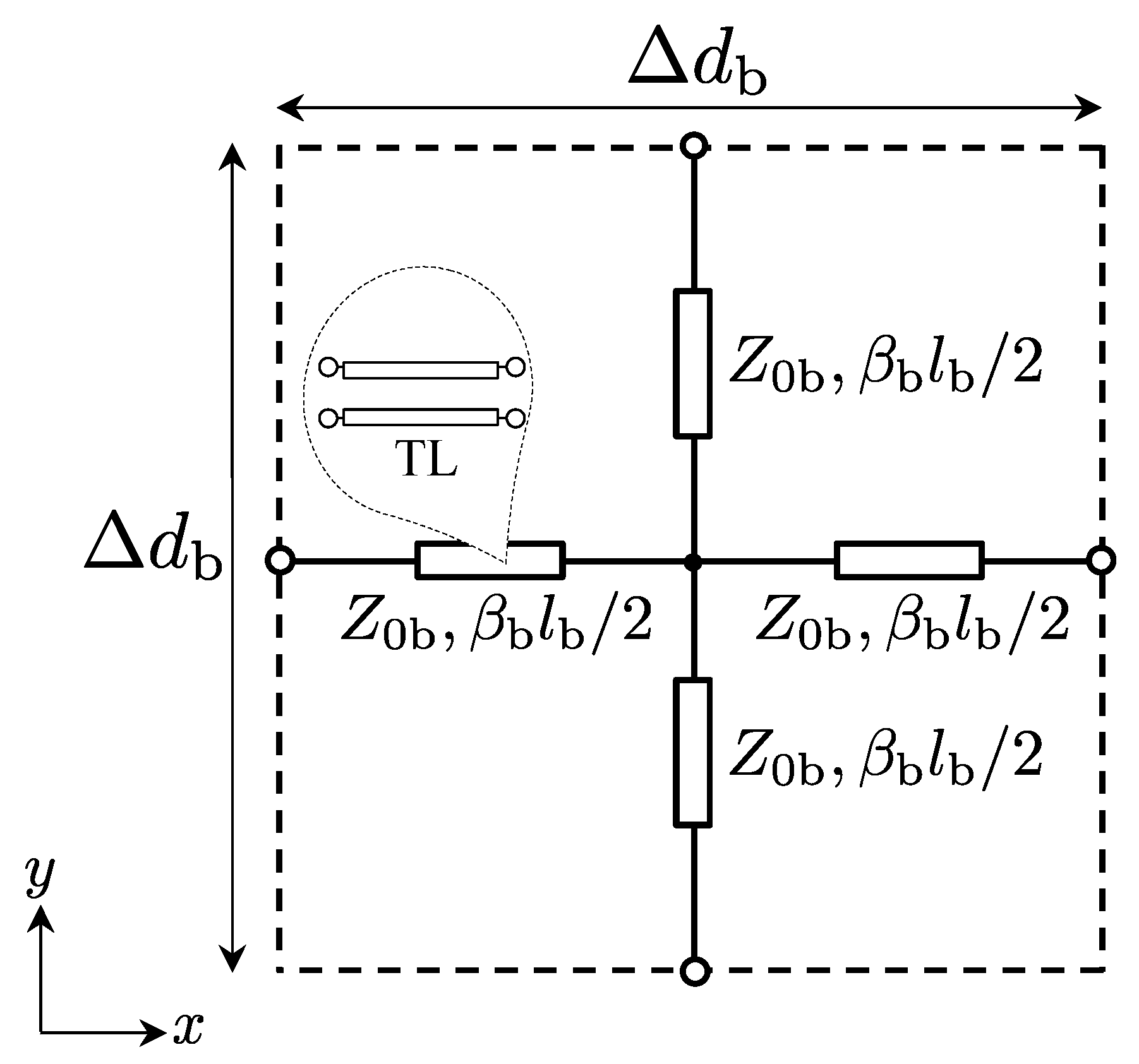

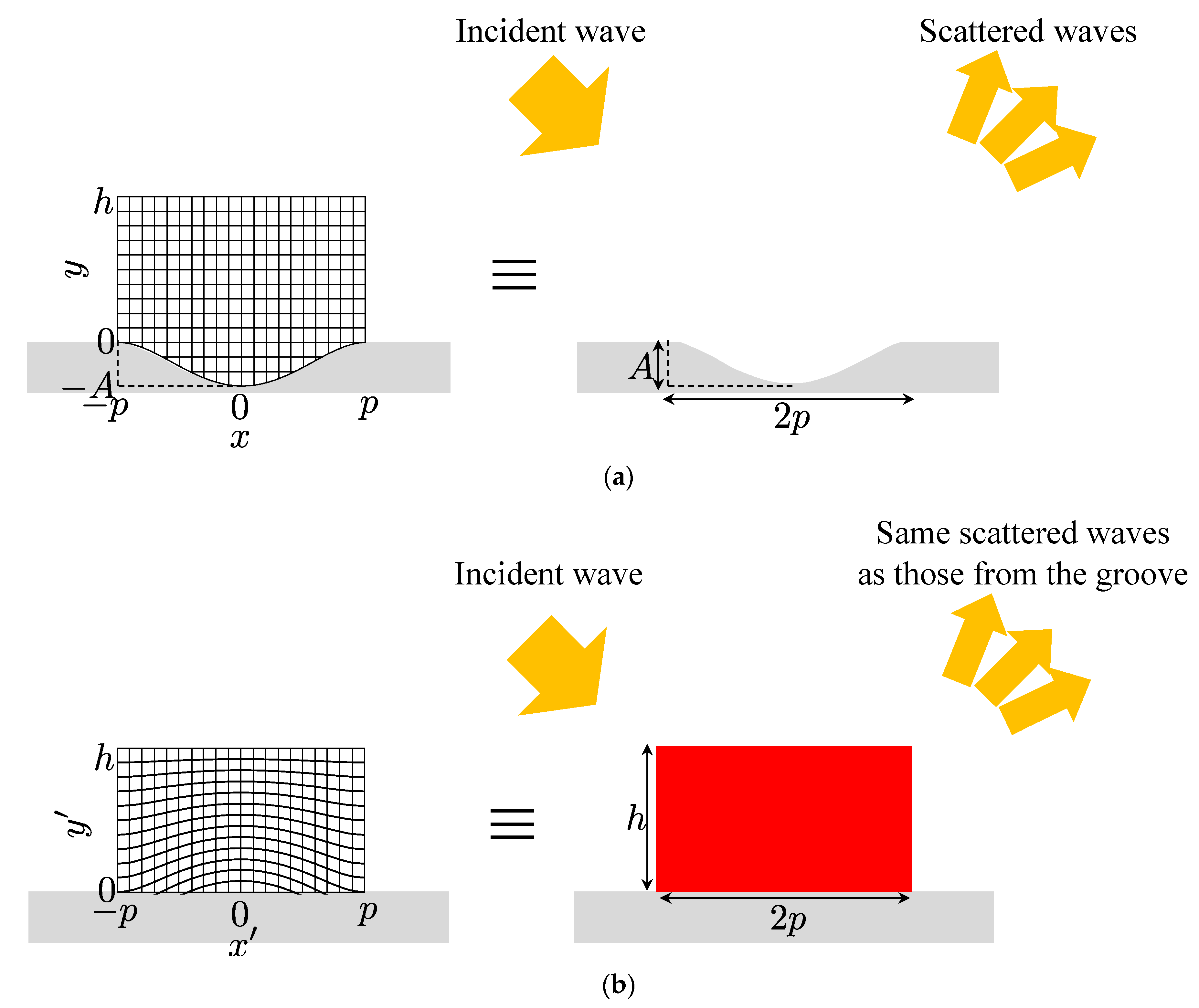
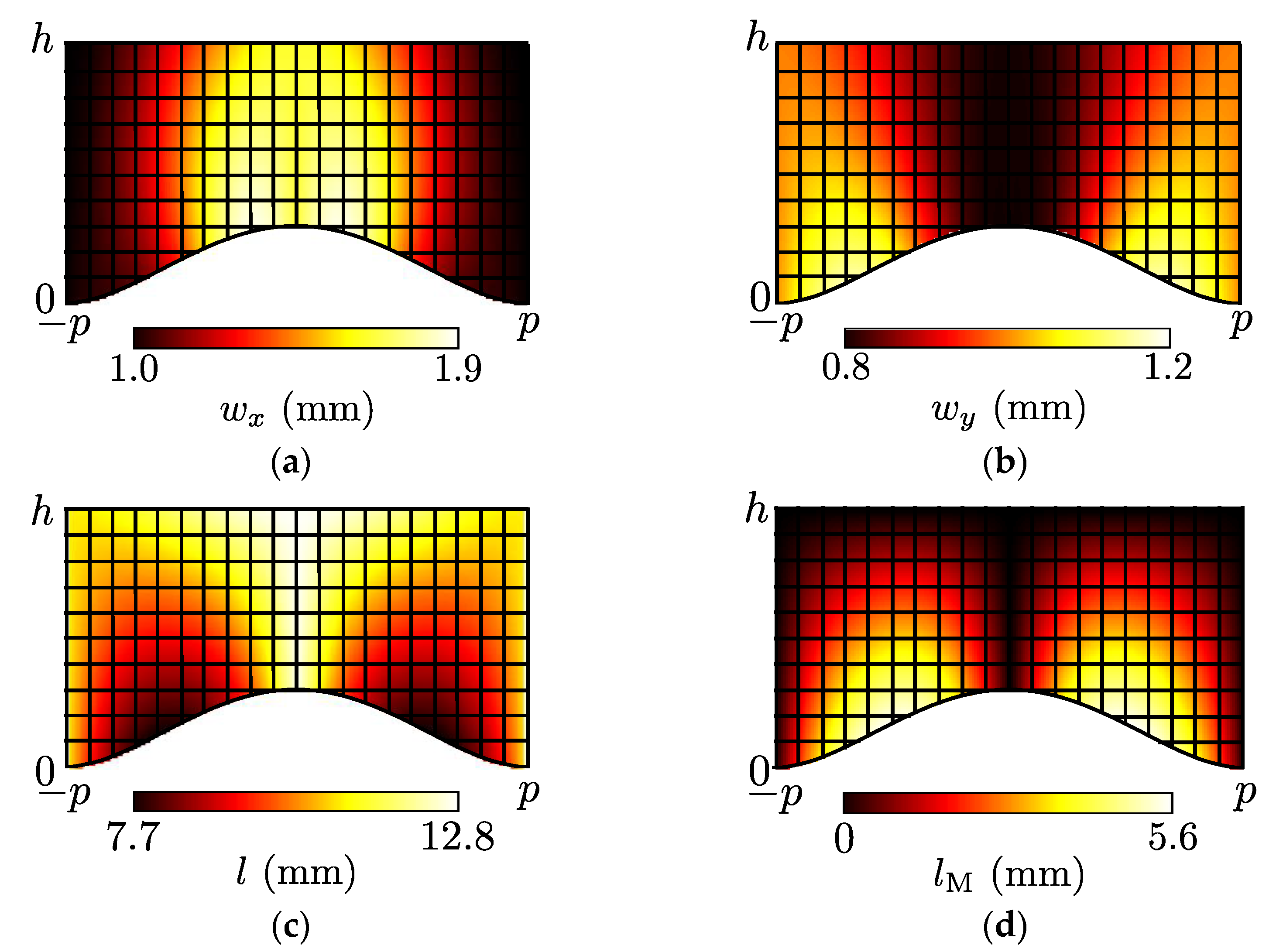


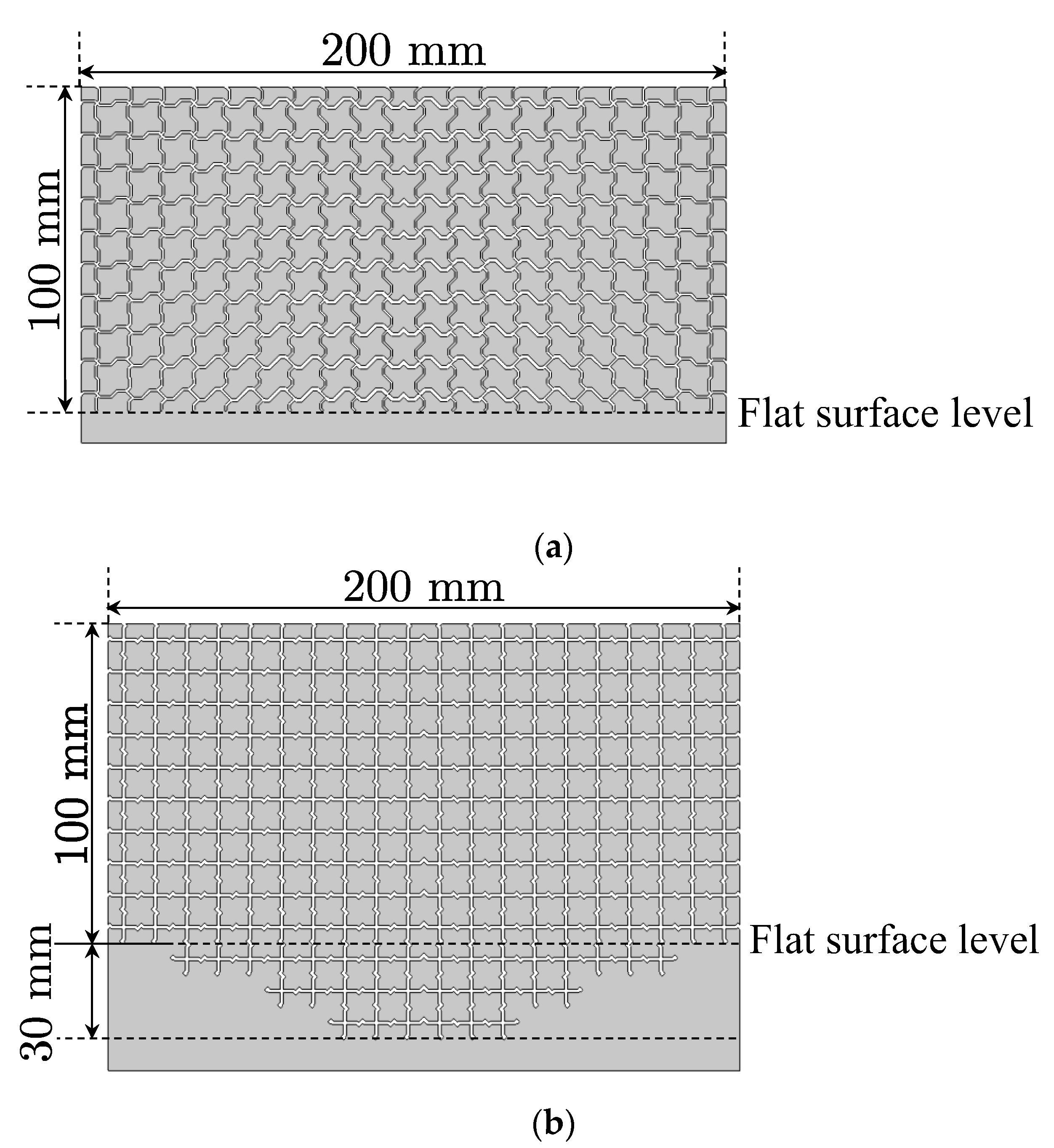
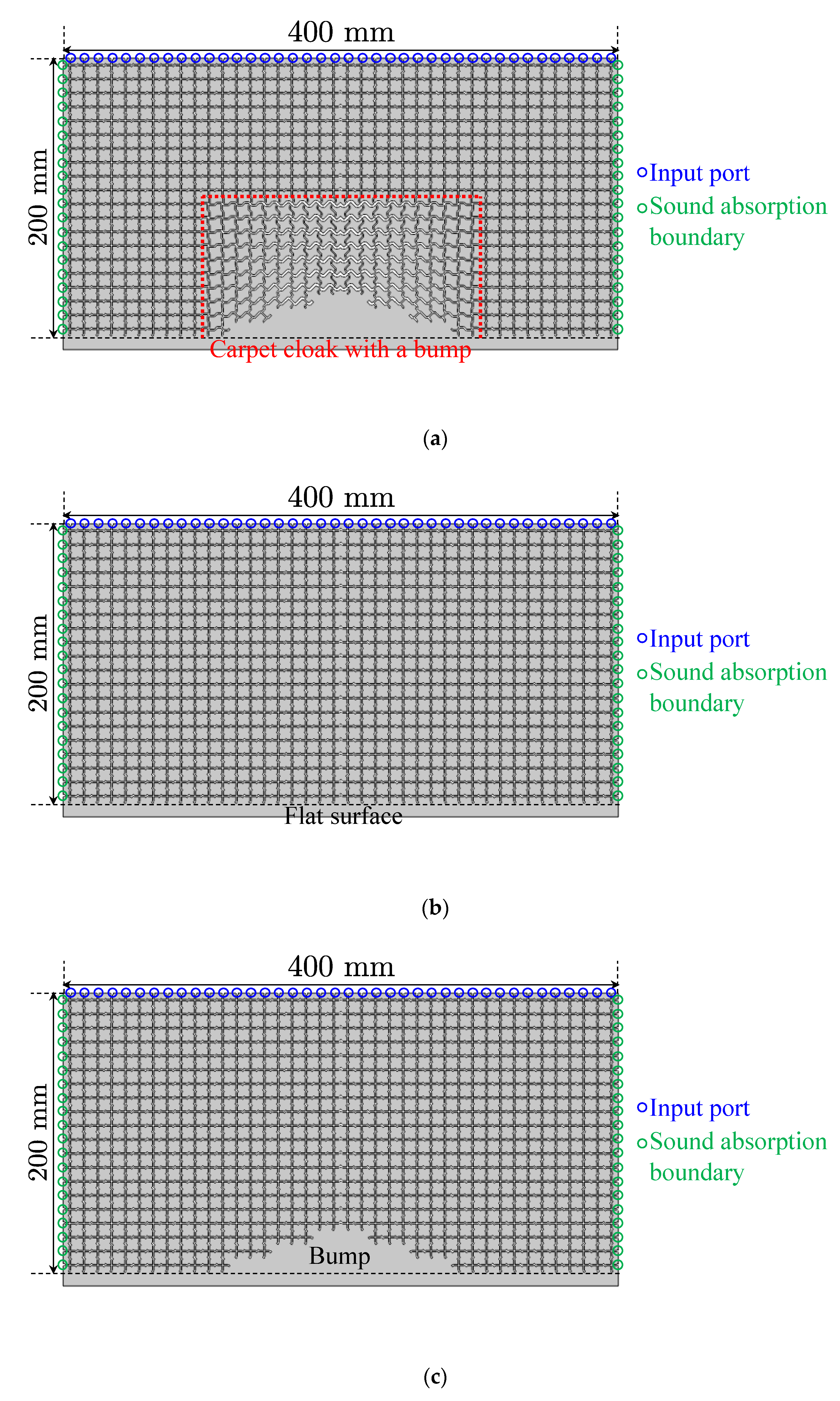
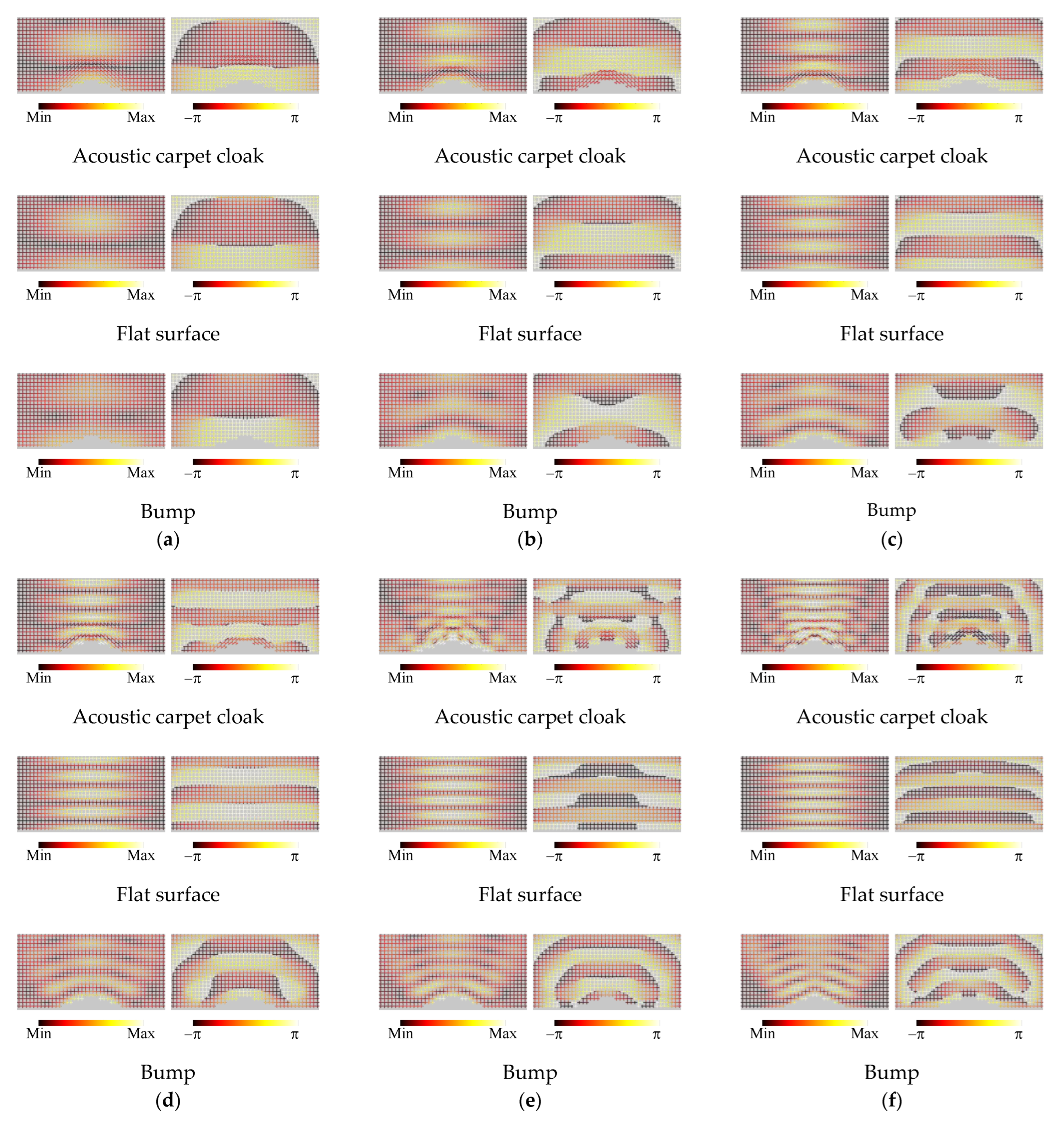


| Circuit Equations | 2-D Maxwell’s Equations | 2-D Acoustic Equations |
|---|---|---|
| Circuit Equations | 2-D Maxwell’s Equations | 2-D Acoustic Equations |
|---|---|---|
Publisher’s Note: MDPI stays neutral with regard to jurisdictional claims in published maps and institutional affiliations. |
© 2022 by the authors. Licensee MDPI, Basel, Switzerland. This article is an open access article distributed under the terms and conditions of the Creative Commons Attribution (CC BY) license (https://creativecommons.org/licenses/by/4.0/).
Share and Cite
Nagayama, T.; Toshima, A.; Fukushima, S.; Watanabe, T. Two-Dimensional Distributed Transmission-Line Models for Broadband Full-Tensor Anisotropic Acoustic Metamaterials Based on Transformation Acoustics. Crystals 2022, 12, 1557. https://doi.org/10.3390/cryst12111557
Nagayama T, Toshima A, Fukushima S, Watanabe T. Two-Dimensional Distributed Transmission-Line Models for Broadband Full-Tensor Anisotropic Acoustic Metamaterials Based on Transformation Acoustics. Crystals. 2022; 12(11):1557. https://doi.org/10.3390/cryst12111557
Chicago/Turabian StyleNagayama, Tsutomu, Akihiro Toshima, Seiji Fukushima, and Toshio Watanabe. 2022. "Two-Dimensional Distributed Transmission-Line Models for Broadband Full-Tensor Anisotropic Acoustic Metamaterials Based on Transformation Acoustics" Crystals 12, no. 11: 1557. https://doi.org/10.3390/cryst12111557






